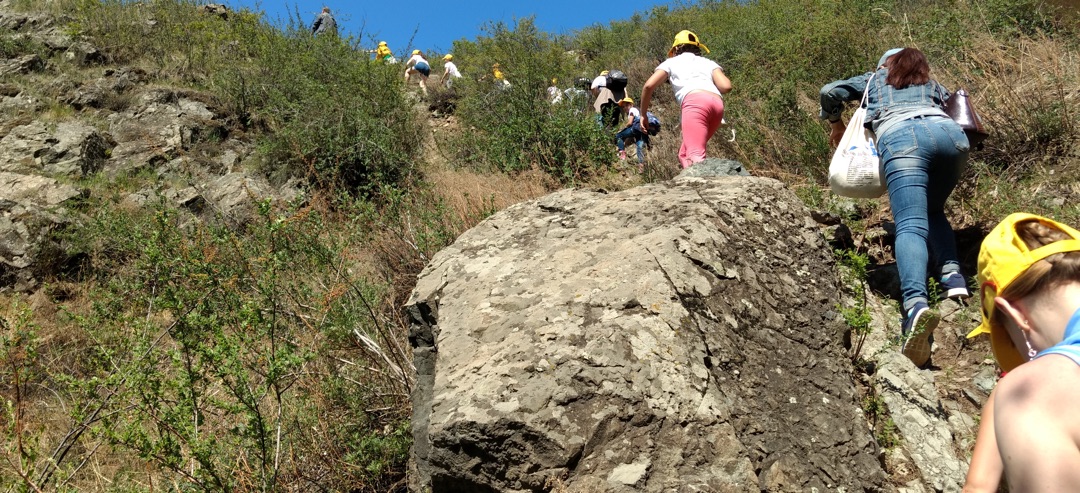My summer in Chita: 12. At the dacha
This summer has been marked by visits to the dachas of friends. Dachas have been a boon in the difficult economy that most Russians have endured for 2-3 generations now as they are almost always the site of a large and productive vegetable garden. In the 1990s, the difficult transitional period from the Soviet economy to the capitalist one, there were figures cited that said one-third of all food eaten by Russians was produced in their dacha gardens. I don’t know if that is still true, but there is no doubt that the size of the gardens and the seriousness with which they are tended shows their importance.

Pasha at the Shadrin dacha (his grandparents’), dusk
Dacha properties are typically 1/4 to 1/2 acre. The buildings for living are generally quite small by American standards–simple cabin-type houses with small rooms: a kitchen, a living room and one or two bedrooms all on one level. The floor plan often matches the old style where the rooms surround the great brick Russian stove in the middle of the house, the woodbox and cooking areas face the kitchen, and the other sides are part of the walls of the other rooms. The stove is filled with internal baffles to spread the heat, warming the house. The outer construction of the house is typically log cabin style. These houses were undoubtedly built by hand by the original owners, so no two are the same. Of course dachas can be quite elaborate and grand, but since most Russians can’t afford that, those one can see of that sort, like along the shore of Lake Arakhley or near the city, stand out. Also, nowadays some people are making their dachas their primary homes and expanding them to two floors. Most dacha properties are in tracts set aside expressly for dachas located near the city. Most are surrounded by high security fences, at least along their outer border, which provide an element of privacy in such close quarters.
Water comes from many sources. Though a dry climate, groundwater here is plentiful and most dachas have wells. Many people have barrels and cisterns collecting water from the roofs of the house, greenhouses, storage buildings, etc. I suspect that few are connected to a municipal water system. I’ve only seen water conserved carefully, by the bucketful. Most dachas have banyas (a water efficient way to bathe). The toilet is an outhouse put as far from the house as possible.

Flowers at the Shadrin dacha. Note the rain barrel at the corner of the greenhouse
With such small housing the area for gardens is maximized. Most gardens have one greenhouse, and often two, one for tomatoes the other for cucumbers and peppers, etc. At least 1/4 of the territory is given to potatoes, usually more. Typically planted: potatoes, cabbages, tomatoes, cucumbers, onions, greens, eggplant, carrots, beets, dill, garlic, other herbs, black currants (the berries for jam, the leaves for tea and flavoring), sea buckthorn/”oblepikha”/???????? (hippophae) (not native to the Americas but common in Asia and Europe, an orange berry with a distinctive flavor), raspberries, strawberries, Beyond that, dacha gardens abound in flowers and experiments.
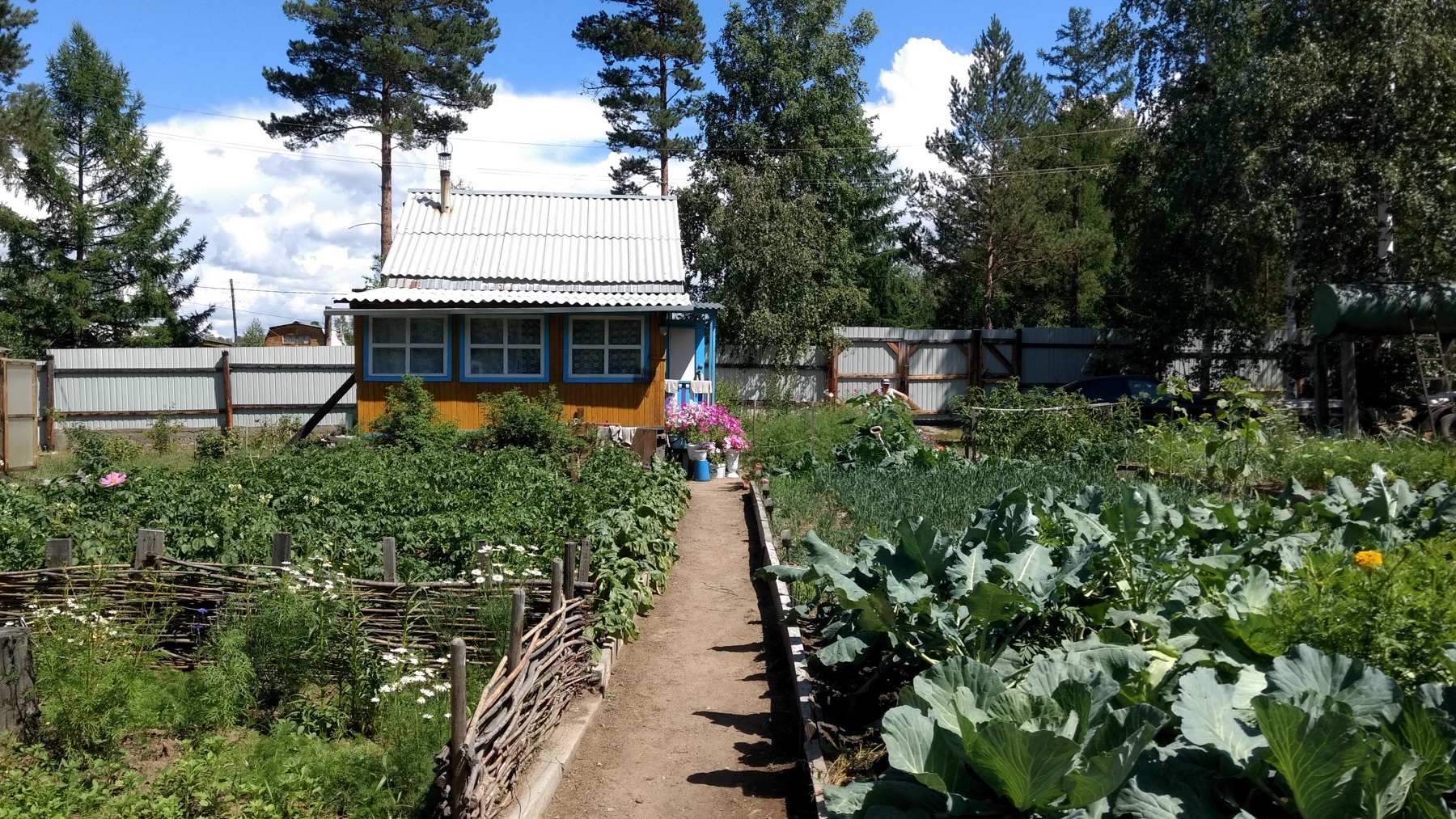
The Kulakovsky-Anisimova dacha
The Kulakovsky-Anisimova dacha: It is about 25 km out of the city beyond the village of Smolyenka and the dacha tract is across the highway from a Memorial–the site of a mass grave for a group of people eliminated during Stalin’s purges in the 1930s. The dacha tract is relatively new and some of it borders on the forest. Victor and Elena’s lot is oversized in a fat “L” shape. At the far end is the banya with an outdoor shower consisting of a large tank raised overhead with a showerhead spigot at the bottom.
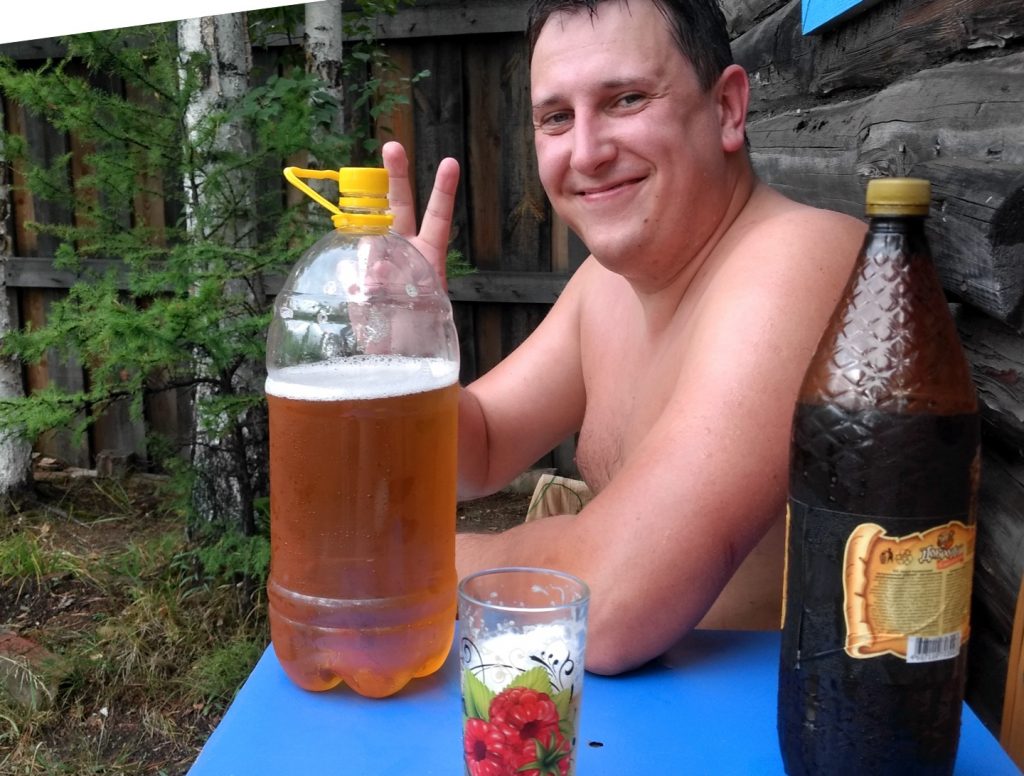
Victor’s son Vova. One of the many kvass/beer breaks during banya.
Facing the banya is the row of raspberries. Coming back up to the dacha house you pass the potato field on the right and squashes on your left. Then a long row of cucumbers and eggplant under a low hooped row-style greenhouse covered with white cloth.
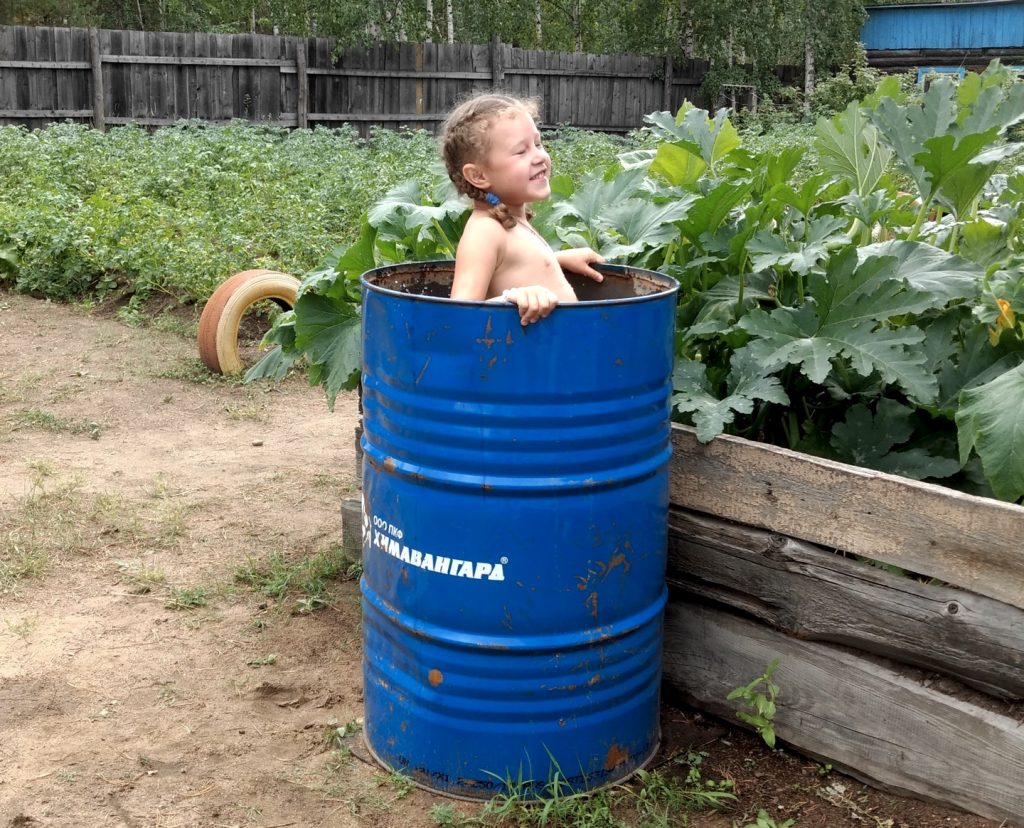
Vova’s daughter, Varya (4), getting a mid-afternoon rinse in one of the many barrels located around the grounds filled with well water and used for watering (and the occasional water fight) She’ll have a banya later with her mother and Elena.
Then the cabbages, onions, and currants along the side. In the short part of the “L” is a large greenhouse for tomatoes and peppers and behind that is an open space where Victor and Elena just finished their gazebo and it will be a lot cooler than the rather closed-in veranda of their small dacha home. There is also a picnic table under a small grove of birches in the corner of the lot. Flowers are found all around the dacha, and there is a large flower garden arranged around narrow circular paths, and among the flowers are a funny collection of garden gnomes and characters, some constructed out of birch branches and chunks.

Olga Fleshler at the entrance to Victor and Elena’s dacha

Those Kulakovskys mugging for the camera in the veranda. From left: Olga Fleshler with Vova, Varya (with the wings over her father), Olya, Elena and Victor
Tanya Sukhanova’s dacha is old, at least 60 years old. It is in Antipikha, a district of Chita at the edge of town on the highway south to Aginsk. Antipikha is one of the city’s oldest dacha tracts and it is enormous–a labyrinthine tangle of dirt roads lined closely on each side by the tall steel security fences. It was one of the first stops on the old local train line that took people to the dacha tracts during Soviet times when cars were few and far between and everyone took public transportation. (Nowadays people drive their cars or use the wonderful “mashrutka” small bus (large van) system seating 12-15 people that go practically everywhere in Chita and the surrounding towns and villages.) There was small central amphitheater for community events in those days. It was her family’s while she was growing and her father built all the buildings: the domik for sleeping, the storage building, the large cistern, the small dining house, the two large greenhouses, and the banya attached to the back of the greenhouses. With her parents deceased and her two sisters married and one moved away to Moscow, it is all hers now, and is rather too big to manage by one person she says. She said it hasn’t been a good year for tomatoes and was somewhat relieved to hear that others were having the same problem at their dachas this year.
Lyuda Kovalchuk’s home is in a residential tract that is part of the village of Smolyenka, lying about 4 km beyond the village center. These are not strictly dachas, though maybe some are used as a second home.
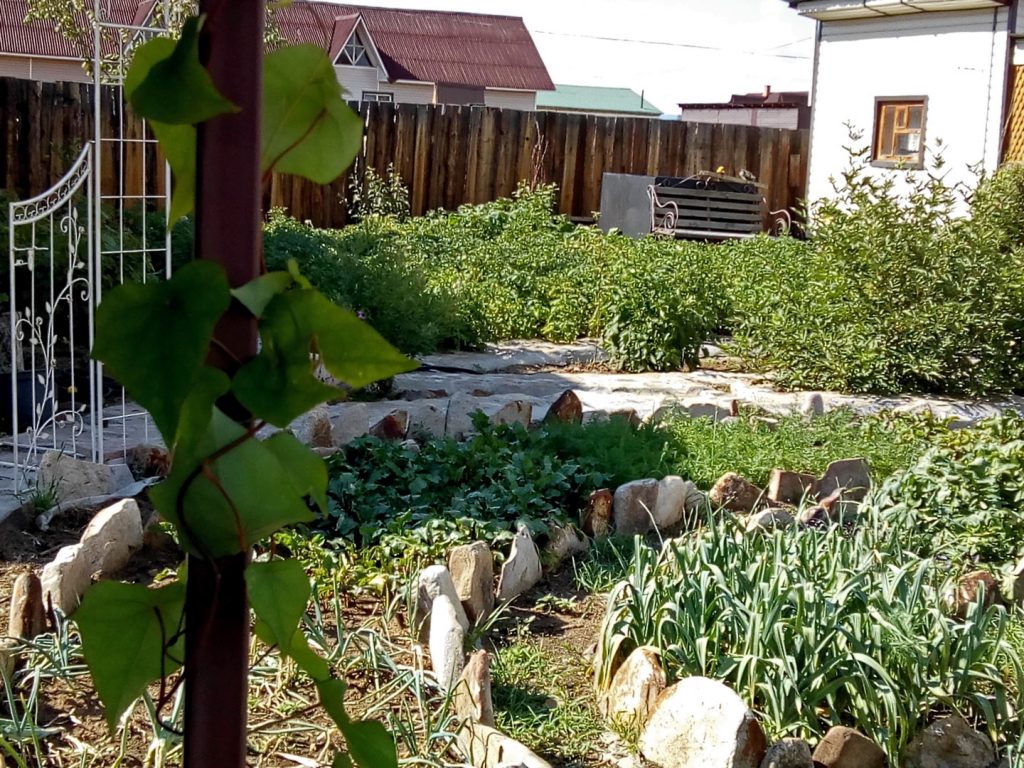
Lyuda Kovalchuk’s home garden–in the style of a dacha
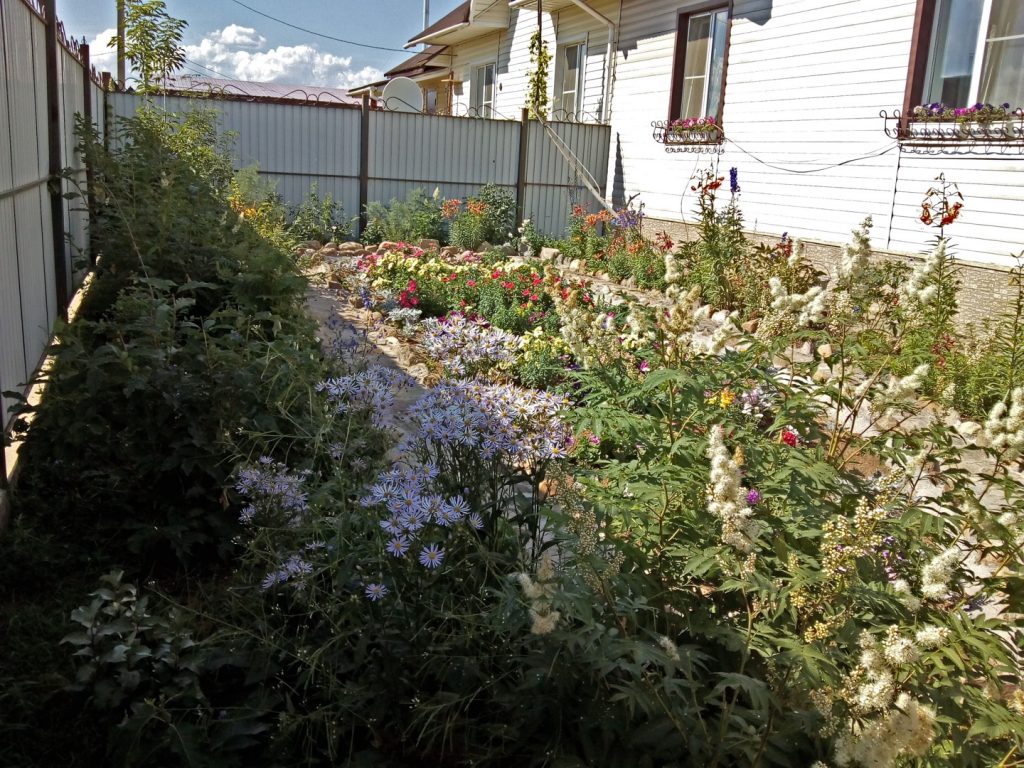
Lyuda’s flower garden
Lyuda, an administrator for a higher education institution in the city, bought this house pre-built (notably with inside plumbing!) from the developer, but without any interior work done. That was all done by her or at her expense. The floor plan is the same as a dacha, even to having a large Russian brick stove in the middle to heat the house, but the dimensions are larger and the feeling more spacious and light. Her property is all densely productive with vegetables and flowers, with a large greenhouse, a banya, a storage shed and a small covered area for outdoor grilling and entertaining.

Lyuda in her arbor where the grill is.
The house is one and a half stories, the 2nd floor room under the roofline. This place had a different feeling than the dacha areas. Though all the houses are hidden behind tall steel fences, on the street (potholed sandy track, really!) were kids on bikes and others hanging around the corner store. At the entrance from the highway to the development was a new small Orthodox church–small footprint (no one sits at services, only stands), but rising 4 stories with its impressive onion domed spire.
The Petrenko home in “old Zasopka”. Again, the Petrenko’s (Gena and Natalia) place is not strictly a dacha since it is their only home. Zasopka is an old village close to the city, but since 2000 it has more than doubled in size to ~3500, with all the new population living in “new Zasopka” down the road, a housing development like Lyuda’s outside Smolyenka. Natalia teaches English at the village school (all eleven grades in one building) and Gena is a retired fireman on workman’s comp. Their two sons, both in their 20s, still live at home. Unlike the three dachas mentioned which are very orderly, if in a rustic way, Natalia’s and Gena’s is a glorious mess, with auto parts and various things set out in the yard everywhere that there is no garden planted. I got the sense that this was a Guys With Projects heaven. Their house is large, two stories, again built entirely by the family itself (schoolteachers and pensioners do not have a lot of money!) One son is a phys. ed. teacher at the school and a physical therapist at a summer sanatorium in the district, the other is a programmer.
The Shadrin dacha at the edge of the forest. Nikolai and Larissa Shadrin are the parents of my and SB’s great friend, Elena Pishcherskaya, wife of Vitaly, mother of Pasha and Sasha (20 mos.). This summer I’ve spent many afternoons and evenings at hers and Vitaly’s apartment in Chita and I finally got a chance to spend the afternoon and evening at the dacha yesterday. Her parents move into the dacha as soon as possible in April (it doesn’t heat well, so it can’t be year-round) and leave in October. Her eight year old son Pasha spends half his summer days and nights there. The dacha is in the same tract as Victor and Elena’s but it is at the far end, and walking out of the steel gate you immediately enter the forest. The place, like the others described, has all the buildings and vegetables and flowers and berry bushes.

Vitaly and the raspberries (ahem…outhouse, in the back…), with the forest just beyond.
Perhaps because they are both retired so they have the time to really work at the garden, it was the greenest, most colorful, and most lush of all the gardens I saw among an impressive set of gardens. The tomatoes and cucumbers in their greenhouses were floor to ceiling jungles of vines, flowers and fruit. Most fun was the gazebo. Just after our arrival, Elena and Larissa set to work cleaning it out for dinner. Elena stopped at one point to thank me for visiting because it caused them to clean it out and bring it back to its original purpose. When we dropped by a few nights before to pick up Pasha, Larissa was drying black currant leaves on the big table for tea and flavoring in the winter and the floor space was filled with stuff.

Elena and the Loch Ness monster look-alike door frame to the gazebo

Flowers beyond the gazebo
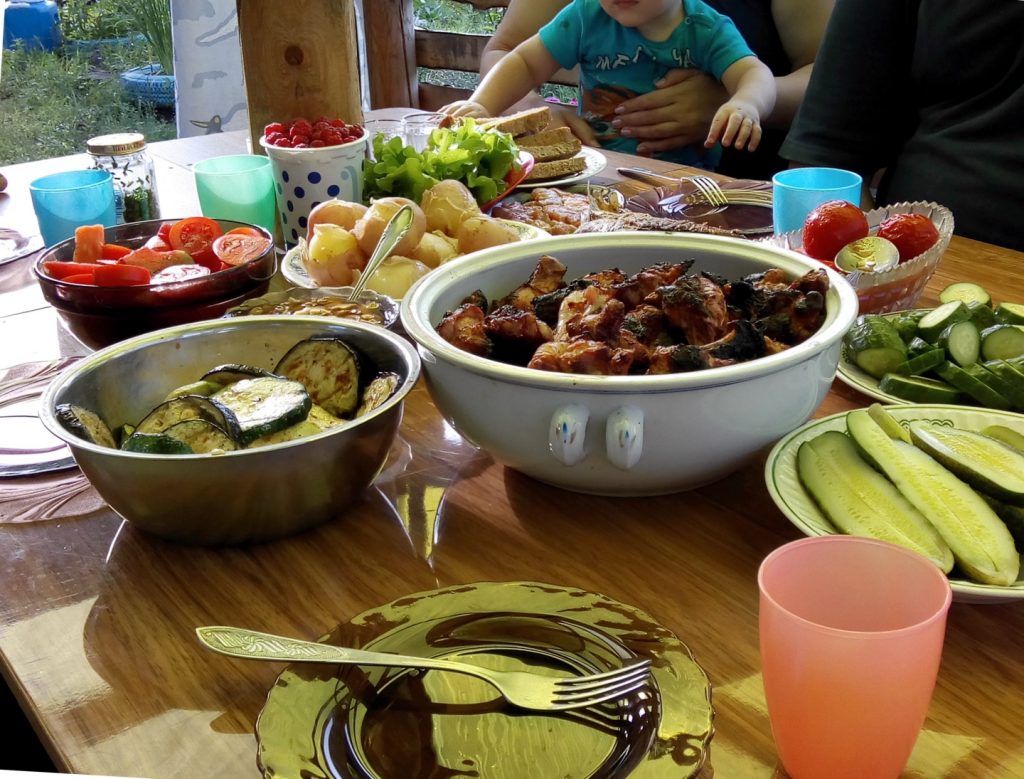
First potatoes of the season, grilled chicken wings and pork ribs, fresh tomatoes, pickled tomatoes, grilled squash and eggplant, half-salt summer pickled cucumbers, pan-fried fish from last winter’s ice fishing, greens, just picked raspberries, and a little jar of chopped wild garlic! Vabshe!
This gazebo’s entrance is a 6 foot tall curved log from the forest cut lengthwise–normally useless unless cut for firewood, but Nikolai liked the curve and the matched halves made a grand entrance. The curves were echoed by large half-circle (3.5 foot diameter) windows that made the upper part of the long walls in this oblong space. The circular windows looked to me impractical to me, and I think they reflected Nikolai’s sense of fun and imagination. Though the half-circle windows contained glass, the area around them was left open. Three hand-cleaned tree poles in a row down the center held up a translucent fiberglass roof and also provided the legs for the large permanent table. At the midpoint of each of the two long walls were displayed the wings of two birds (small hawks?) killed by Nikolai, a professional hunter, now retired. We sat in this space for a dinner of grilled ribs and chicken wings and small pan fried fish caught last winter through the ice, of wild garlic greens, chopped and salted, of wild mushrooms salt-cured, and half-salt summer cucumbers, fresh tomatoes, and raspberry compote–a rich red drink of boiled raspberries, sugar and water–and the star of the meal: the first potatoes from the garden, served simply boiled–delicate and flaky.

Shadrin’s tomato greenhouse
After dinner Vitaly, Pasha and I had a banya and then returned for tea and sweets, conversation, swatting at flies, and watching the beautiful and slow sunset. Nikolai, with his tanned and deeply creased face telling of a life lived outdoors (though not a grey hair despite his 70 years) warmed, through time and toasting, to asking about hunting elk, and hunting in general, in the US. I could only say a few things, not being a hunter myself, though I knew elk were hunted again in Colorado, the large herds due to overprotection. He said they couldn’t be hunted in Zabaikalye now, their numbers reduced, he thought primarily due to poaching. And he told stories from his university days. Elena struggled to translate, laughing a lot because Nikolai’s Russian was so particular and his delivery slyly humorous. Elena went off for her own banya and Nikolai continued to talk. I told him I was missing a lot of the detail, though I thought I got the general direction of his words, and he said that was all that was important, that Russian is complicated in any case.
At the end of the evening when putting on my sandals in the covered walkway between the dacha and the banya, I saw that the tree poles holding up roof were each carved and painted differently. One had a one inch band spiralling up the tree Nikolai had painted blue, another had rings painted green, and so on. Elena had pointed out that Nikolai noticed the half logs that arched to form the entrance to the gazebo looked like the head and long neck of the Loch Ness monster, so he painted them gray and gave them red eyes. Just before leaving the dacha gate for the car, Nikolai grabbed my arm and took me back down the path beside the dacha to a flower bed, and in the darkness asked me to crouch down. Then he gathered the branches of a low plant together for me to smell the small white blossoms. It was magical–very sweet and strong. He said this is only aromatic in the evening. He had to ask Larissa for the name of the flower: meriola. And then he looked at me and smiled–yet again–exuding the contentment and joy he projected the whole visit, the same with 20 month old Sasha, the same with his wife and daughter and son-in-law, the same with me: “Just smell that!”

Sasha among the berry bushes and flowers

